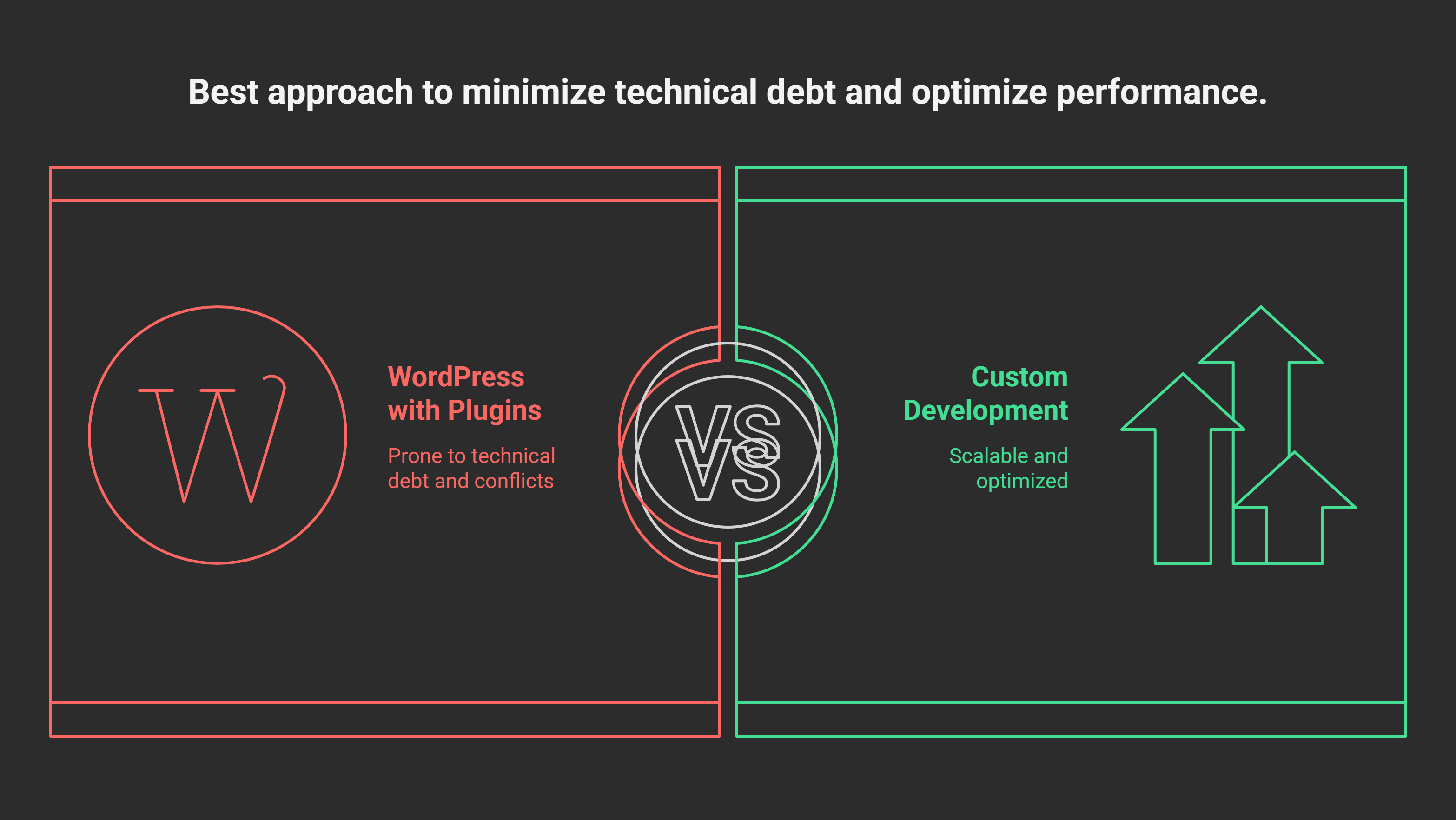Struggling to Manage Your eCommerce Content Effectively?
Running an eCommerce business means managing a constant flow of content—product descriptions, customer reviews, images, promotions, SEO strategies, and more. If your content isn't organized, updated, and delivered properly, you're losing control of your sales process. Every time a product listing is outdated or your site’s SEO is neglected, customers move on—and you lose sales.
This is where most eCommerce businesses struggle. Content becomes fragmented across different platforms, marketing teams can’t keep up with real-time updates, and SEO opportunities slip through the cracks. Sound familiar? If you’re nodding, you’re not alone. Most businesses face the same problem: content chaos.
Right now, you might be using a traditional CMS like WordPress or patching together tools like Shopify and BigCommerce. They work—sort of. But they often fall short in key areas:
- Limited Flexibility: Your CMS locks you into rigid templates, forcing you to work around its limitations instead of customizing it to fit your needs.
- Fragmented Content: You’re likely using multiple tools to manage different types of content—product pages, blogs, and email marketing are all handled separately. The result? An inconsistent customer experience.
- Slow Updates: Updating content in real-time, especially for promotions and product launches, is essential. Most systems make this difficult, causing delays that cost you sales.
- SEO Shortcomings: SEO is critical for driving traffic, but many platforms don’t give you the control you need over critical elements like meta descriptions, URLs, and schema markup.
According to a recent study, 79% of customers abandon a website that’s hard to navigate or filled with outdated content. That’s a lot of lost revenue simply because content is poorly managed.
Imagine this:
- You can update every piece of content across all platforms in real-time.
- You can easily tailor content to fit your customer’s preferences, delivering a personalized experience that drives sales.
- Your content remains consistent across your website, mobile app, and even your email campaigns.
- SEO becomes a breeze, with full control over meta tags, sitemaps, and more.
- Your team collaborates effortlessly, updating content instantly without waiting on approvals or getting bogged down by slow systems.
That’s the perfect solution for any eCommerce business. And I’ve got good news: Sanity CMS makes it all possible.
Here’s how you can use Sanity CMS to streamline your eCommerce content management process.
Example: Setting Up a Product Schema
This schema defines the structure for your product content, including fields for price, stock, and SEO metadata.
Example: Fetching and Rendering Products in Frontend
Using a frontend framework like Next.js, you can fetch and display Sanity data:
Sanity CMS solves the content chaos problem by giving you full control over your eCommerce content. Here’s how:
- Total Flexibility: Sanity doesn’t lock you into pre-made templates. It lets you build exactly what you need, whether you’re creating custom product pages, dynamic landing pages, or personalized customer experiences.
- Centralized Content: Instead of juggling multiple tools, Sanity lets you manage all your content in one place. Whether it’s product descriptions, customer reviews, or marketing materials, you can organize and update everything from one dashboard.
- Real-Time Updates: No more waiting. Sanity allows real-time collaboration, so your teams can update content instantly—just in time for that big sale or product launch.
- SEO Made Easy: Sanity gives you granular control over SEO elements like meta tags, structured data, and URLs. No need for extra plugins or third-party tools. You can optimize every page for search engines directly from Sanity.
Study Spotlight: Businesses that switched to a headless CMS like Sanity reported a 20-30% increase in website performance and a 15% drop in bounce rates, leading to higher conversion rates .
Sanity CMS isn’t just another tool; it’s your ticket to better content management and more sales. Here’s why:
- Personalization at Scale: Deliver targeted content based on your customers' behavior, preferences, or location. Personalization drives conversions, and Sanity makes it simple.
- Future-Proof Technology: Sanity’s headless architecture means your content is ready for whatever platform you need—websites, apps, even in-store displays. You’re never locked into one system.
- Seamless Integration: Sanity plays well with others. Whether you’re using Shopify, Stripe, or another service, Sanity integrates smoothly, making it a natural extension of your existing tools.
- Collaboration Without the Hassle: Your marketing, SEO, and content teams can work together in real-time without any delays. Everyone can contribute at once, cutting down on time wasted waiting for approvals.

Big names like Nike, Sonos, and Figma already use Sanity to manage their content. Why? Because it works. These companies have been able to streamline their processes, deliver personalized customer experiences, and boost sales by having complete control over their content.
Every day you stick with outdated, inefficient systems is a day you’re losing potential revenue. You need a solution that gives you full control over your content and sales process, and Sanity does exactly that.
It’s never too late to switch, and with Sanity’s free tier, you can start taking control of your content today. As your business grows, Sanity grows with you, ensuring you never have to worry about outgrowing your CMS.
Sanity is the tool that empowers you to take full control of your eCommerce content and, ultimately, your sales process. It’s flexible, fast, and optimized for SEO, making it the perfect solution for businesses ready to cut through content chaos and start boosting conversions.
Ready to stop losing sales to content chaos? Start using Sanity CMS today and get back in control of your eCommerce business.
Meet Dennis, a seasoned software engineer with 11 years of experience transforming ideas into digital reality. He has successfully guided countless projects from concept to deployment, bringing innovative solutions to life. With a passion for crafting exceptional software, Dennis has helped countless clients achieve their goals.
Click here to learn more
Popular Posts
- How Can Strategic Software Solutions Propel Your Business to the Next Level?
- What is the Key to Startup Success?
- Why Do Some Products Soar While Others Flounder?
- Why Is Consistent Blogging Critical for Your Go-To-Market Strategy?
- Why Do Some Products Stick While Others Don't?
- The Ultimate Solution for Faster, Scalable, and Customizable Web Design Without the CSS Headaches
- Revolutionizing Your Software Experience
- How Can You Overcome Common Pitfalls in Enterprise Application Software Development and Achieve Success?
- Discover the Ultimate Solution to Streamline Your Workflow and Boost Productivity!
- Is Your Startup Idea Worth It? Discover How an MVP Can Save You Time and Money
Ready to take your business to the next level? Let’s make it happen.
Recommended For You

Why Most Businesses Lose Customers—and How to Take Back Control with Blogging in E-commerce

Unlock Faster, Safer Websites: Why Businesses Are Choosing Next.js Over WordPress

Why Settle for Less? How Custom Web Development Fuels Your Business Growth

Is WordPress Failing Your Business? Discover Why Next.js and Sanity Are the Future of Content Publishing

Astro vs Next.js: Choose the Right Tool for Your Website—Boost Speed, SEO, and User Experience

Why Your Web Development Choices Are Hurting Your Business

Next.js: The Game-Changing Framework to Boost Performance, SEO, and Scalability for Modern Websites

